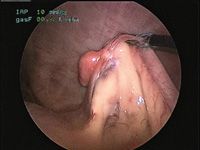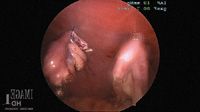Surgery STAT: Laparoscopic ovariectomy: A minimally invasive alternative to a spay
In place of traditional ovariohysterectomies, consider this technique, which results in a quicker recovery time as well as less pain.
Ovariectomy is the removal of the ovaries alone and has been preferentially performed in European communities for many years as opposed to ovariohysterectomy, which is the mainstay of American animal population control procedures. A comprehensive literature review comparing the advantages and disadvantages of both techniques found that ovariectomy was technically less invasive, eliminated the possibility of ureter ligation at the uterine body and had no increased risk of endometritis or pyometra in correctly ovariectomized healthy female dogs.1 There was also no increase in the risk of long-term uterine pathology (i.e., malignant neoplasia) and no difference in weight gain or occurrence of urinary incontinence.

Dr. Buote
Laparoscopic procedures have become increasingly available and demanded by our clientele because of the benefits of decreased patient morbidity (less postoperative pain and quicker return to normal activity). Following is an overview of how to perform a laparoscopic ovariectomy.
Required equipment
The instrumentation required to perform a laparoscopic ovariectomy includes a laparoscopic tower (monitor, endoscopic camera, xenon light source, CO2 insufflator and image recording device); a 5-mm, 0- or 30-degree telescope; 6-mm trocar-cannula components; a vessel-sealing device and laparoscopic instruments (a blunt probe, Kelly or Babcock forceps).
Precautions
Important considerations for laparoscopic procedures include contraindications, such as diaphragmatic hernia and septic peritonitis, in addition to anesthetic considerations. During insufflation, intra-abdominal pressures should not be greater than 12 to 15 mm Hg or cardiovascular or respiratory compromise could occur during anesthesia. End-tidal CO2 should be monitored to avoid hypercapnia.
Procedure
Place the anesthetized patient in dorsal recumbency in such a way that allows the ability to tilt the patient to the left and right after port placement to facilitate visualization of the ovaries. This can be accomplished either by using a specially designed tilt table or by having staff manually move the patient during the procedure.
Once the patient is draped, the first step is to establish a pneumoperitoneum. This allows better visualization and as well as safer introduction and manipulation of instruments within the abdominal cavity. A pneumoperitneum can be created with a Veress needle or the Hasson technique. The Veress needle technique requires blind penetration with a specially designed needle to insufflate the abdomen before a trocar-cannula assembly is introduced. The Hasson technique is performed by dissecting down through the linea and introducing your first trocar-cannula 1 cm caudal to the umbilicus, on midline, with a blunt obturator.

Photo 1: An intraoperative photo of laparoscopic graspers elevating the uterine horn and ovary.
Once the abdomen is appropriately insufflated, introduce the telescope through the first cannula, and place an instrument cannula half way between the subumbilical port and the pubis on midline. Through this port, use instruments to grasp the proper ligament and elevate the ovary (Photo 1). Then tack the ovary to the body wall by passing a suture percutaneously through the body wall and then back out through the skin. Grasp the free ends of the suture next to the body wall to keep the ovary suspended. Be careful not to pass this suture through the ovarian pedicle as hemorrhage will obscure visualization and may require conversion to an open procedure. Next, introduce a vessel-sealing device, and transect the proper ligament, pedicle and mesovarium (Photo 2).

Photo 2: An intraoperative photo of a transected ovary (left) held to the body wall with percutaneously placed suture.
Once this procedure has been performed on both ovaries, remove the ovaries through an enlarged instrument port incision. Finally, inspect the abdomen for evidence of hemorrhage, and close the port sites routinely.
Postoperative care
After surgery, monitor patients for signs of hemorrhage, and manage them appropriately for pain (hydromorphone 0.05 mg/kg IV every six hours or buprenorphine 0.01 mg/kg IV every eight hours). Even though the incisions are much smaller (less than 2 cm) than with the traditional procedure, discharge instructions for owners include keeping incisions clean and dry. Incisions are usually closed in two layers—a linea/fascial layer and subcuticular—without skin sutures, so owners don't need to return for suture removal. Activity restriction requirements are less strict than with the traditional procedure—patients should be kept quiet for only five to seven days after surgery, and, generally, only a two-day course of an anti-inflammatory medication is needed.
Dr. Buote was awarded Diplomate status in the American College of Veterinary Surgeons in 2010 after completing a residency at the Animal Medical Center in New York City. She is a published author on the subject of laparoscopy and heads the minimally invasive surgery department at VCA California Animal Hospital Veterinary Specialty Group in Los Angeles, Calif.
REFERENCE
1. Van Goethem B, Schaefers-Okkens A, Kirpensteijn J. Making a rational choice between ovariectomy and ovariohysterectomy in the dog: a discussion of the benefits of either technique. Vet Surg 2006;35(2):136-143.